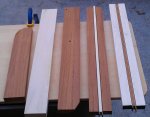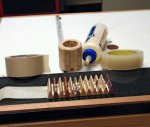Onlinebear
New member
- Joined
- May 2, 2018
- Messages
- 2
I create striped boards out of different woods, then cut the boards into small "wedges" to glue together into a circle/column. All that to turn the column into ornaments/containers/wine stoppers. I'm looking for Excel formulas to calculate how many linear inches of board I need to create the circle/columns. Here is what I know to start the problem:
Number of Wedges: 16
Desired Outside Diameter of Circle/Column: 2.0 inches
Desired Inside Diameter of Circle/Column: 0.5 inches
Width of Sawblade: 0.10 inches
Outside width of Wedge: 0.353 inches
Inside Width of Wedge: 0.088 inches
First I cut one segment width from the end of the board to set the cutting angle.
Second I flip the board over and cut the first wedge. Then flipping the board again to cut second wedge... and so on. This flipping wastes only the width of the saw blade for each wedge.
I've been using this formula, but I end up using significantly more linear feet of wood. Where did I go wrong
=((DesiredNumberOfSegments/2)*OutsideSegmentLength)+((DesiredNumberOfSegments/2)*InsideSegmentLength)+((DesiredNumberOfSegments+2)*BladeWidth)+(2*OutsideSegmentLength)
 .
.  .
.  .
. 
Number of Wedges: 16
Desired Outside Diameter of Circle/Column: 2.0 inches
Desired Inside Diameter of Circle/Column: 0.5 inches
Width of Sawblade: 0.10 inches
Outside width of Wedge: 0.353 inches
Inside Width of Wedge: 0.088 inches
First I cut one segment width from the end of the board to set the cutting angle.
Second I flip the board over and cut the first wedge. Then flipping the board again to cut second wedge... and so on. This flipping wastes only the width of the saw blade for each wedge.
I've been using this formula, but I end up using significantly more linear feet of wood. Where did I go wrong
=((DesiredNumberOfSegments/2)*OutsideSegmentLength)+((DesiredNumberOfSegments/2)*InsideSegmentLength)+((DesiredNumberOfSegments+2)*BladeWidth)+(2*OutsideSegmentLength)
 .
.  .
.  .
. 
